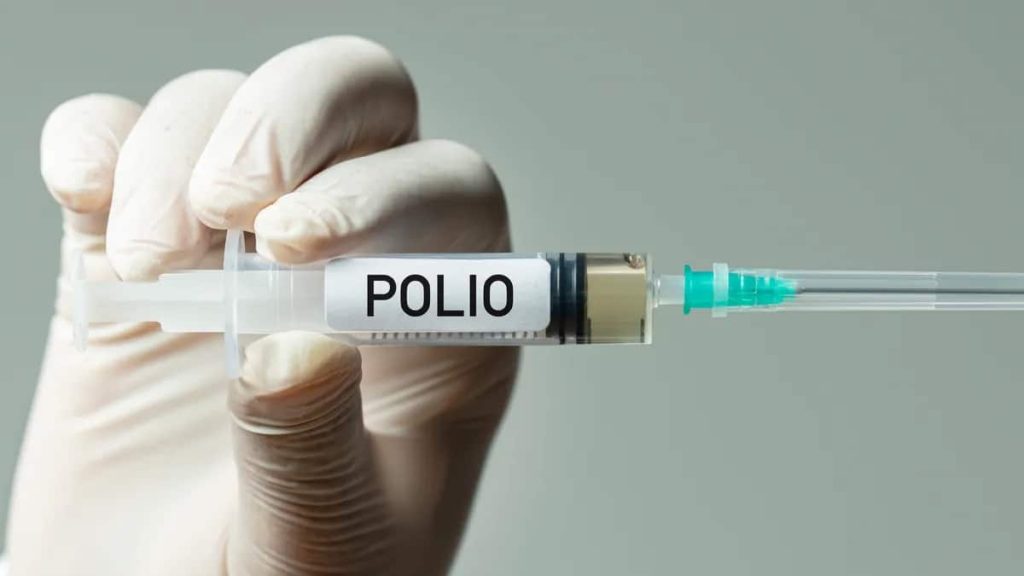Poliomyelitis, commonly known as polio or infantile paralysis, is a viral infection that primarily affects children under the age of 5. While many infections cause only mild symptoms, polio can invade the nervous system and lead to permanent paralysis or even death.

Polio: Understanding the Disease
The poliovirus is a member of the enterovirus family and is spread mainly through the fecal-oral route. This means that the virus is transmitted through contaminated food or water or by direct contact with an infected person. Although a global effort to eradicate polio has been underway for decades, cases still occur in certain regions.
Polio Symptoms
Most people infected with the poliovirus don’t develop any noticeable symptoms. When symptoms do appear, they can range from mild to severe. Polio infections fall into three main categories:
- Asymptomatic (Silent) Infection: Most people with polio (about 72%) have no visible symptoms.
- Abortive Poliomyelitis (Minor Illness): This involves mild flu-like symptoms such as fever, headache, sore throat, nausea, vomiting, and fatigue, lasting a few days.
- Non-paralytic Poliomyelitis (Aseptic Meningitis): This more severe form involves the membranes covering the brain and spinal cord becoming inflamed, causing neck stiffness, headache, fever, back pain, and vomiting.
- Paralytic Poliomyelitis (Major Illness): This is the rarest but most severe form of polio. It affects the central nervous system, causing muscle weakness and paralysis. Paralysis can range from mild to severe, impacting the limbs or even the muscles involved in breathing.
Polio Transmission
The poliovirus spreads mainly through:
- Fecal-oral transmission: Contaminated food or water, or objects (such as toys) contaminated with infected feces.
- Oral-oral transmission: Saliva or droplets from a sneeze or cough of an infected person.
- Poor hygiene: Failing to wash hands properly after using the toilet or changing a diaper can contribute to its spread.
Polio: Preventive Strategies
The most effective way to prevent polio is through vaccination. Two types of polio vaccines are available:
- Inactivated Poliovirus Vaccine (IPV): Given as an injection, it contains killed (inactivated) poliovirus that triggers the body’s immune system to create antibodies to protect against polio infection.
- Oral Poliovirus Vaccine (OPV): Given orally (drops), it contains a weakened (attenuated) form of the poliovirus. OPV replicates in the intestine, creating immunity but may rarely cause vaccine-associated paralytic polio (VAPP).
MedicW: Medical Consumables in the Fight Against Polio
- Syringes: Essential for delivering IPV vaccinations effectively and safely. MedicW’s high-quality syringes are designed for single use, ensuring sterility and preventing needle-stick injuries.
- Sampling Swabs: Vital for collecting stool samples to test for the presence of the poliovirus in surveillance programs and for confirming a diagnosis in suspected cases. MedicW’s sterile swabs provide reliable collection and transportation of specimens for accurate lab analysis.
- Nitrile Gloves: Offering critical hand protection for healthcare workers involved in administering vaccinations, handling samples, and providing care to patients suspected or confirmed to have polio.
- Personal Protective Equipment (PPE): MedicW provides a comprehensive range of PPE, including gowns, masks, and eye protection, crucial in preventing the spread of the virus in healthcare settings.
Polio Treatment
Unfortunately, there is no cure for polio. Treatment focuses on supportive care and minimizing the impact of symptoms:
- Pain Relief: Managing muscle pain and spasms with medications and therapies.
- Physical Therapy: Improving muscle strength and function through exercise and rehabilitation.
- Ventilatory Support: In severe cases of respiratory muscle paralysis, providing mechanical ventilation to help with breathing.
Polio: Addressing Your Concerns
1. What are the long-term effects of polio?
Answer: The long-term effects of polio can be significant, ranging from mild to severe, and often including permanent paralysis or muscle weakness, joint deformities, post-polio syndrome (new muscle weakness developing years after initial infection), and chronic pain.
2. Can adults get polio?
Answer: Yes, adults who were not vaccinated or exposed to the virus during childhood can get polio. They are generally more likely to experience severe symptoms.
3. Is polio contagious?
Answer: Yes, polio is very contagious and spreads easily, particularly among individuals with poor hygiene practices.
4. Is there a cure for polio?
Answer: There is no specific cure for polio, only treatments to manage the symptoms and support the patient. Prevention through vaccination is the key to controlling this crippling disease.
5. What should I do if I suspect I or someone I know might have polio?
Answer: Seek medical attention immediately. It is important to get a proper diagnosis and supportive care. Inform your healthcare provider about any recent travel or contact with a suspected polio patient.
6. Why is polio still a concern when there is a vaccine available?
Answer: Despite the effectiveness of polio vaccines and significant global progress in eradicating the virus, challenges remain. Vaccine hesitancy, disruptions in vaccination campaigns (especially in conflict zones), and the potential for the emergence of vaccine-derived polioviruses (rarely from the oral polio vaccine) highlight the need for ongoing vaccination efforts and surveillance.
Polio: Conclusion
Polio, while largely preventable, remains a severe and potentially debilitating illness. It’s a poignant reminder that vaccination remains our strongest weapon against this devastating disease.
MedicW plays a pivotal role by supplying healthcare professionals and organizations with essential medical supplies, enabling them to administer vaccines, manage potential outbreaks, and ensure the safety of frontline workers while providing quality care.
We urge everyone to:
- Ensure they and their families are fully vaccinated against polio.
- Practice proper hygiene, particularly handwashing.
- Support global polio eradication efforts.
By collaborating and diligently implementing public health strategies, we can overcome the hurdles and achieve a polio-free world.
MedicW is committed to being your trusted partner in providing high-quality medical consumables. Explore our comprehensive range of products and discover how we can support your healthcare needs. Visit us at medicw.com or contact our team at [email protected].
Link to this article: Polio: Understanding and Preventing the Crippling Disease
